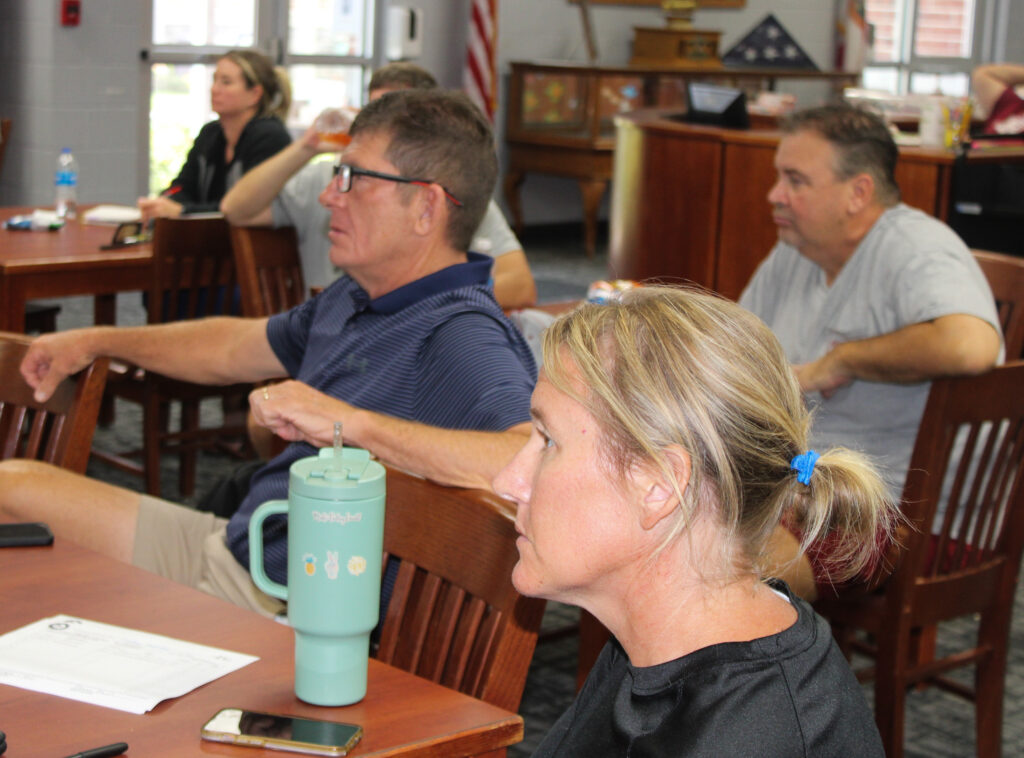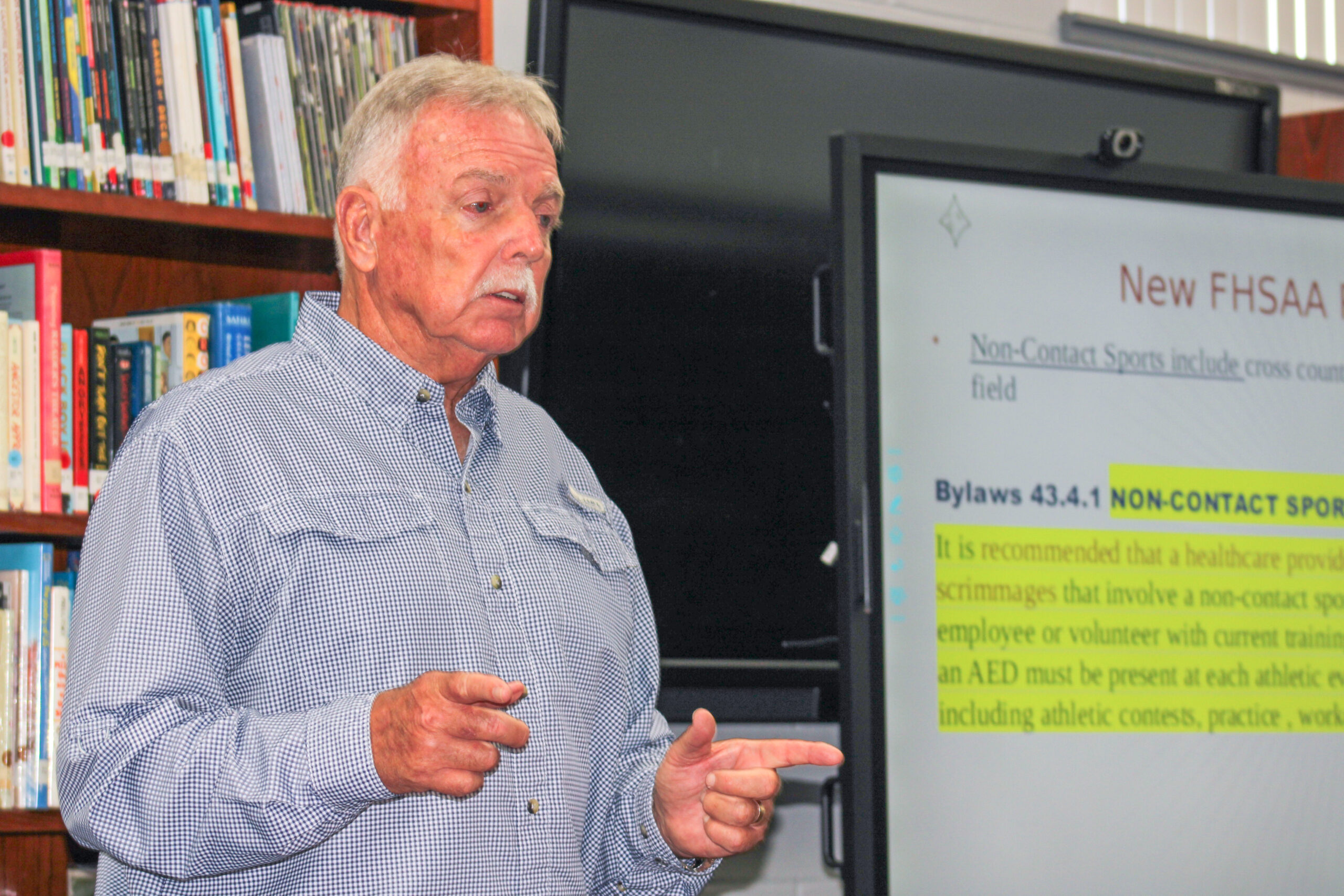Athletic departments adapt to new rules
It is customary to break up intense practice sessions in high school athletics with some joking around, a little lighthearted banter, some horsing around.
But it’s no laughing matter when it comes to the health and well-being of student athletes.
Last week, in preparation for the start of the fall seasons, coaching staff in both the Franklin and Gulf county school districts attended sessions conducted by Rick Williams, a longtime athletic trainer and currently director of sports medicine outreach for Tallahassee Orthopedic Clinic.
He presented a pair of Power Points, one created by attorney Bob Harris, general counsel for the Panhandle Area Educational Consortium (PAEC) and the other by Williams, whose overview reviewed everything from the new rules adopted by the Florida High School Athletic Association (FHSAA) to detailed bullet points regarding the latest advisories on how best to handle heat exhaustion and stroke, sudden cardiac arrest and concussions.
“The idea is to keep kids alive,” he said. “And to keep you out of court.”
Key to the changes are the requirement that a certified health care provider, anyone from a doctor to a nurse to a trainer, attend all games, and in the case of the collision sports of football and wrestling, also be accessible at all practices.
Bobby Johns, the countywide athletic director in Gulf County, said that having emergency medical techs either at the field, or very close by, as well as coaches that are all first aid certified, at both schools in Gulf County fulfills that requirement. “Basically it’s a push to make sure there’s someone qualified who can assist,” he said.
In his talk, Williams stressed that schools must each have a health safety coach, and that the districts must go further than just having access to automated external defibrillators (AED), but need to have them close by, with well-established protocols for their use. With precious few seconds ticking away in cases of sudden cardiac issues, these AEDs can make a difference between life and death, he said.

Johns said Gulf County already has two AEDs at each end of the county, and will be adding a third, for a total of six to cover all sports, including golf in Port St. Joe and cross country at both schools
“Those are precautions this year to make sure everyone is taken care of and safe,” he said, noting that the district will be running a scheduled simulated emergency during a practice, on a subject such as heat stroke, concussion, heart issues or even lightning to make sure coaches know both the rules and how they are implemented.
“We will video it and we’ll make corrections,” Johns said.
“When we look at sudden cardiac arrests, you’re lucky if you have minutes,” said Josh Dailey, Gulf County’s assistant superintendent. “It’s one thing to have a plan, it’s another thing to execute a plan. If the unthinkable does happen, we want to make sure we can respond.”
The district also plans to add two more immersion tubs at either end of the county, for a total of five in both places, to address the rapid cooling that is required during those instances when heat can get the better of an athlete. Johns said each sport with an outdoor component is asked to have 30 gallons of ice readily available to be used.
Both school districts plan to have someone at every outdoor practice and game to do wet bulb thermometer readings prior to and throughout, all in order to adhere to the strict protocols the state has listed at each temperature level. Johns said he has asked all coaches to submit these numbers to him regularly so he can keep abreast of these temperature readings.
At the session with coaches, Johns relayed a story about how he once had to do CPR for nearly a half hour on a young man with a broken neck.
“He didn’t pass away, he survived, but was paralyzed,” he said. “We wish nothing had happened. Had I been more prepared, maybe there were things I could have done even a better job.
“If a kid dies on our watch, that’s way more important than how many games we’ve won,” Johns said.


Meet the Editor
David Adlerstein, The Apalachicola Times’ digital editor, started with the news outlet in January 2002 as a reporter.
Prior to then, David Adlerstein began as a newspaperman with a small Boston weekly, after graduating magna cum laude from Brandeis University in Waltham, Massachusetts. He later edited the weekly Bellville Times, and as business reporter for the daily Marion Star, both not far from his hometown of Columbus, Ohio.
In 1995, he moved to South Florida, and worked as a business reporter and editor of Medical Business newspaper. In Jan. 2002, he began with the Apalachicola Times, first as reporter and later as editor, and in Oct. 2020, also began editing the Port St. Joe Star.